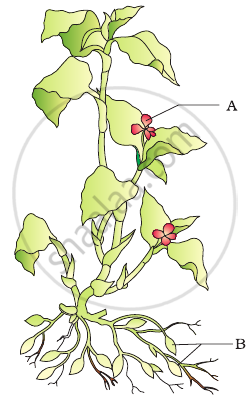Advertisements
Advertisements
प्रश्न
There are four tiny organisms A, B, C and D. The organism A is a parasitic protozoan which causes a disease known as kala-azar. The organism B is a microscopic single-celled animal which causes malaria disease in human beings. The organism C is a unicellular animal which can change its body shape according to need, it has no fixed shape. The organism D is also a unicellular animal which is slipper-shaped having a large number of tiny hair all around its body.
(a) Name the organisms A, B, C and D
(b) Name one characteristic body feature of organism A.
(c) Name the insect which carries organism B and transmits it from one person to another.
(d) What name is given to the asexual method of reproduction of (i) organism A, and (ii) organism B?
(e) Where do organisms C and D live?
उत्तर
(a) The organism A is Leishmania, B is Plasmodium, C is Amoeba and D is Paramecium.
(b) One body feature of organism A is that it has a whip-like structure called flagellum at one end.
(c) Female Anopheles mosquito carries the organism B and transmits it from one person to another.
(d) (i) Organism A reproduces by binary fission.
(ii) Organism B reproduces by multiple fission.
(e) Organisms C and D are found in ponds.
APPEARS IN
संबंधित प्रश्न
How does multiple fission occur in an organism? Explain briefly.
How will an organism be benefited if it reproduces through spores?
An organism having a whip-like structure at one end which reproduces by the process of binary fission is :
(a) Hydra
(b) Paramecium
(c) Leishmania
(d) Plasmodium
A filamentous alga X is found in ponds, lakes and slow-moving streams. The filament of this alga simply breaks into two (or more) pieces on maturing and each piece then grows to become a complete new alga.
(a) Name an alga which X is likely to be.
(b) What is the colour of X?
(c) What is the method of forming new algae by the breaking of parent alga known as?
(d) An Amoeba also breaks up to form two daughter Amoebae. What is the difference in the splitting of Amoeba and splitting of this alga as a method of reproduction?
(e) Name one marine animal which reproduces in the same way as alga X.
After observing the prepared slides of binary fission in Amoeba and budding in yeast following observations were reported:
(a) Single cells of Amoeba and yeast were undergoing binary fission and budding respectively.
(B) Cytokinesis was observed in the yeast cell.
(C) Elongated nucleus was dividing to form two daughter nuclei in Amoeba.
(D) A chain of buds were observed due to reproduction in Amoeba.
The correct observation(s) is/are:
(A) a and c
(B) b only
(C) c and d
(D) d, a and c
Name a multicellular organism which reproduces by fragmentation method.
List in tabular form two differences between binary fission and multiple fission.
Give the name of the plant that reproduces vegetatively by: Bulbils
Seed formation without fertilization in flowering plants involves the process of ______.
In the figure given below the plant bears two different types of flowers marked ‘A’ and ‘B’. Identify the types of flowers and state the type of pollination that will occur in them.

